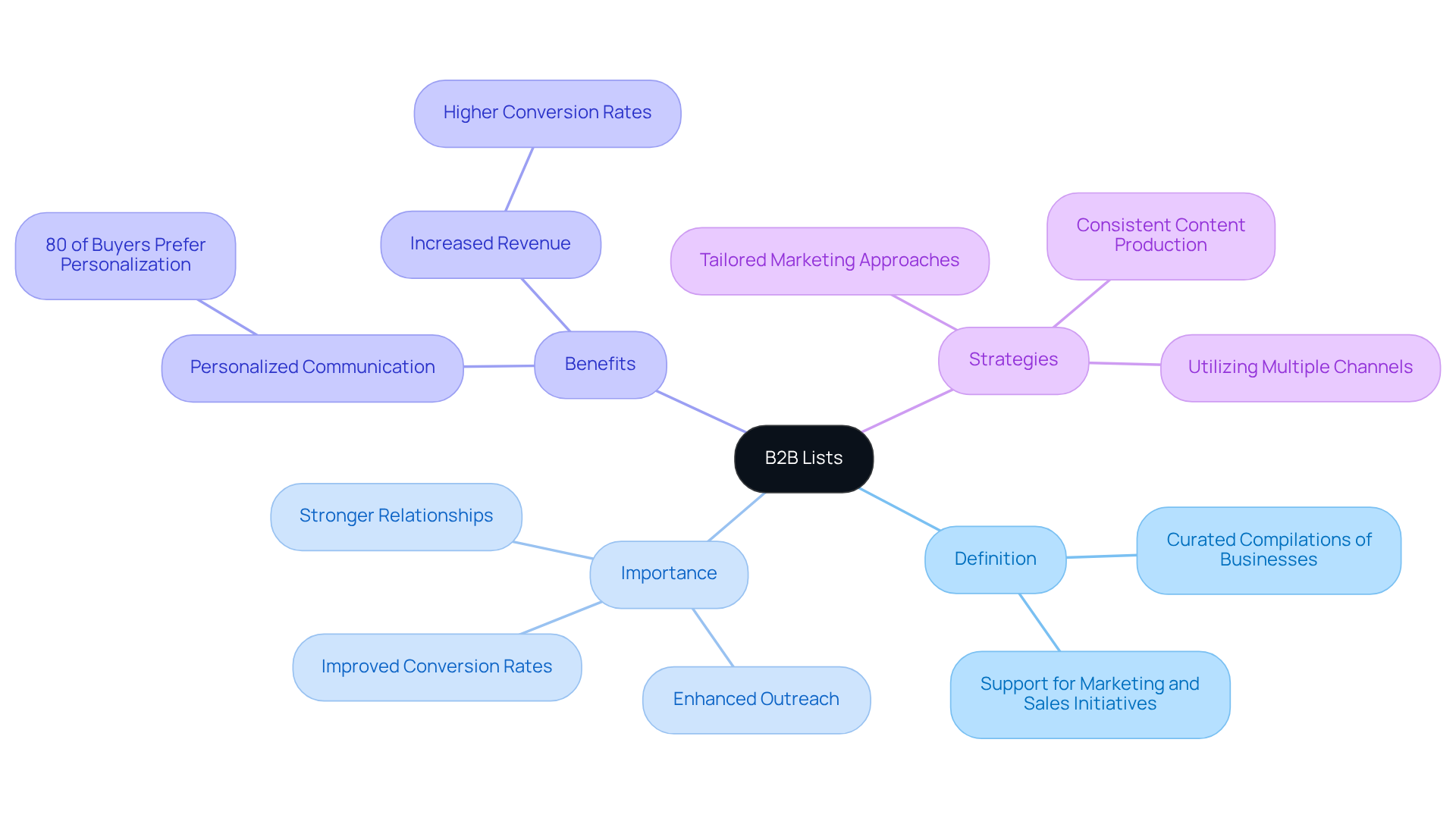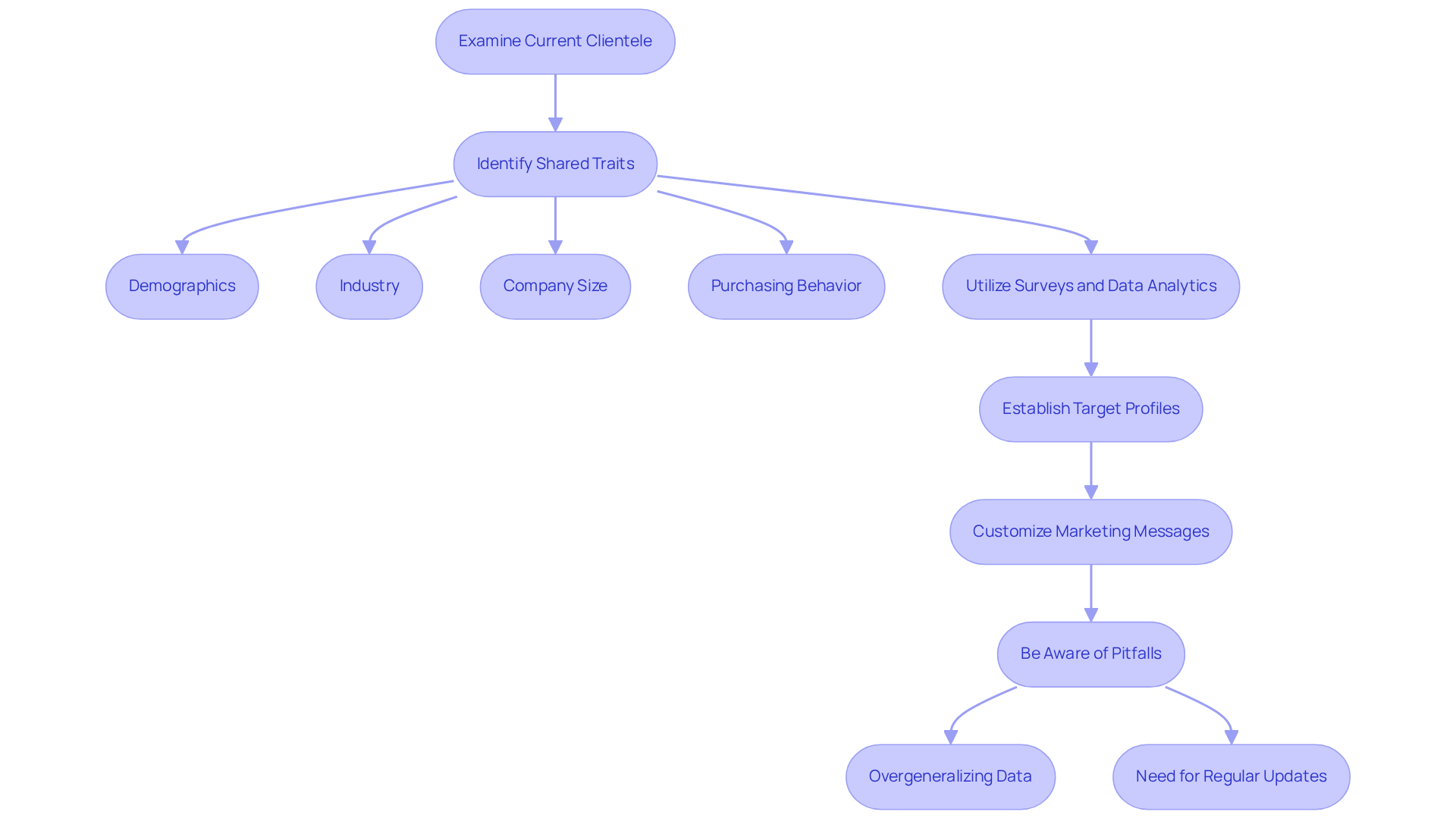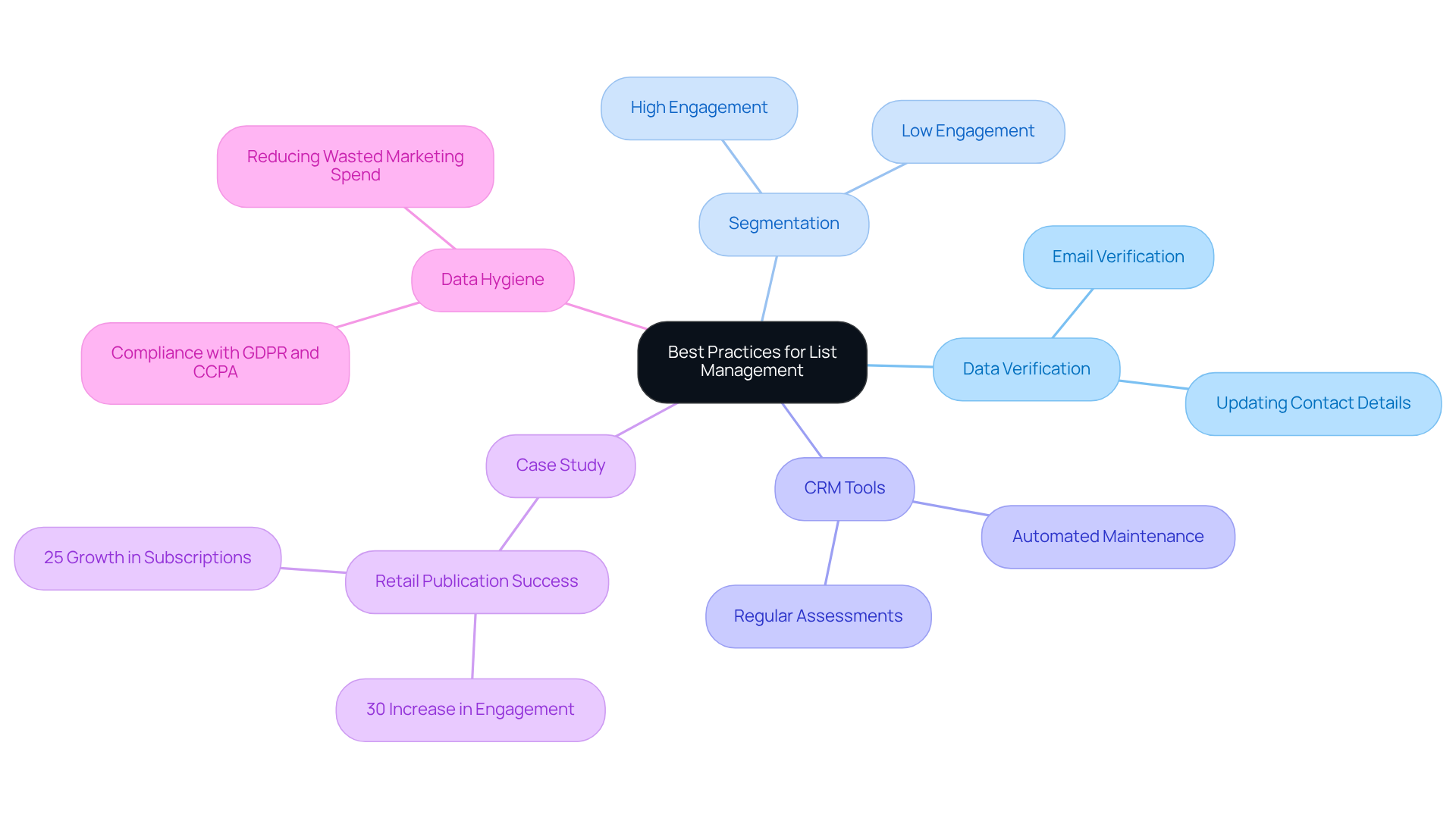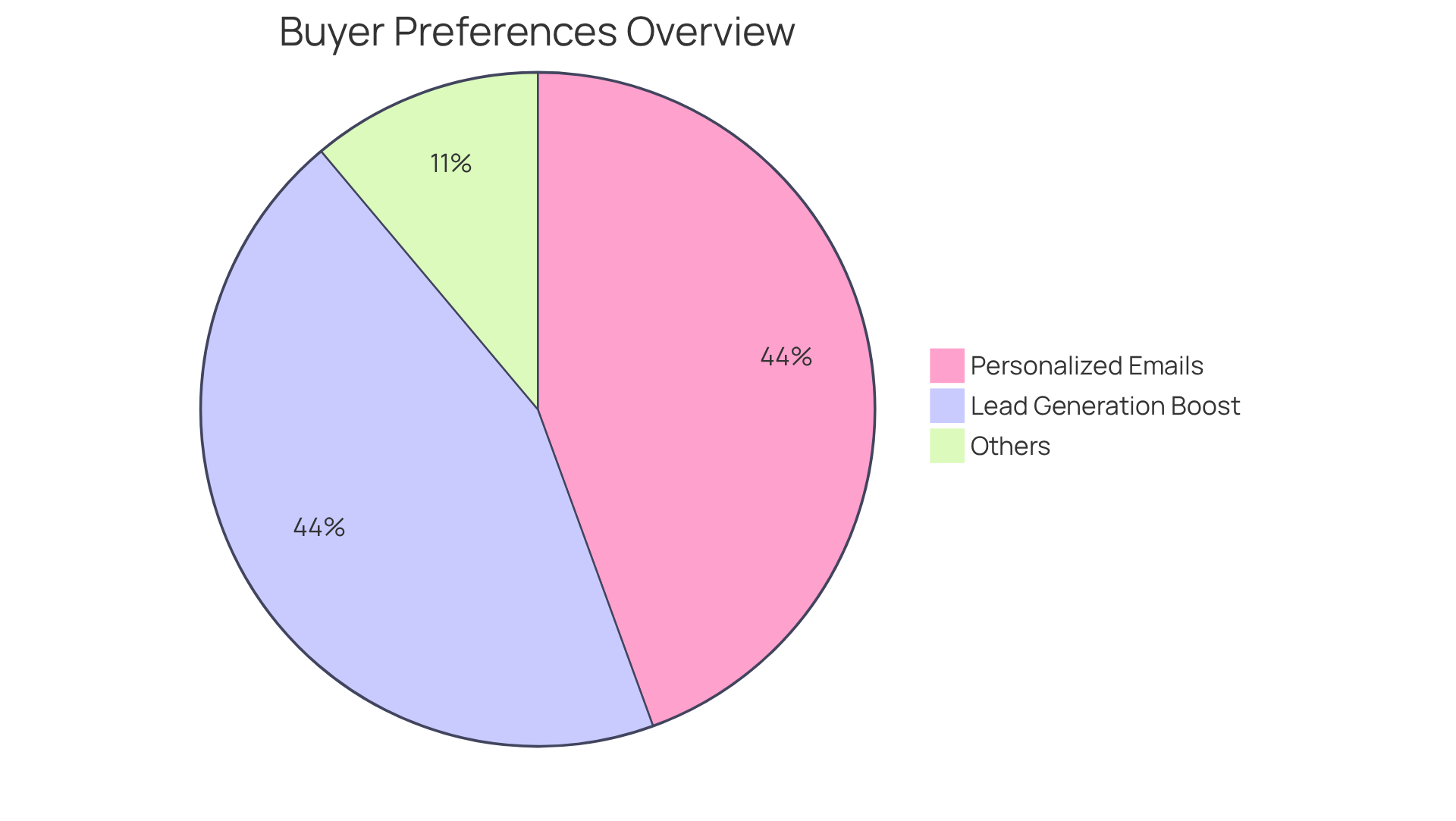Overview
In today's competitive landscape, managing B2B lists effectively is crucial for small business owners. We understand the challenges you face, and that's why we want to share four essential practices that can truly make a difference:
- Developing target customer profiles allows you to connect with the right audience.
- Implementing best practices for list maintenance ensures that your contact information remains accurate and actionable.
- Leveraging automation and AI can enhance your engagement efforts, making your outreach more effective.
- Tailoring your marketing strategies empowers you to utilize advanced technologies that drive sales success.
By focusing on these key areas, you can improve your outreach and conversion rates, ultimately leading to greater sales achievements. Together, we can navigate these challenges and achieve success in your business journey.
Introduction
B2B lists are truly the backbone of effective marketing and sales strategies, yet we understand that many organizations struggle to harness their full potential. By delving into the intricacies of list management, businesses can unlock significant benefits, such as:
- Improved conversion rates
- Stronger client relationships
However, a challenge remains: how can companies effectively manage and maintain these lists to ensure they are not only current but also strategically aligned with their target audiences? Together, we can explore these questions and find solutions that empower your business to thrive.
Define B2B Lists and Their Importance
B2B lists are thoughtfully curated compilations of businesses or contacts designed to support your marketing and sales initiatives. These collections include potential clients, partners, or leads that align with the specific criteria relevant to your offerings. The significance of B2B databases lies in their power to enhance your outreach efforts, ensuring that your marketing messages resonate with the right audience.
When managed effectively, these records can lead to remarkable improvements in conversion rates, stronger customer relationships, and ultimately, increased revenue. Imagine having a well-organized inventory that allows you to categorize your audience by sector, organization size, or buying habits. This organization promotes tailored marketing approaches that truly connect with each group.
This targeted strategy not only boosts engagement but also nurtures a deeper connection with prospects. Personalized communications have been shown to significantly increase the likelihood of conversion; in fact, 80% of commercial buyers prefer to purchase from companies that offer personalized experiences. This underscores the essential role of effective B2B management and the use of B2B lists in driving your sales success.
Moreover, consider that businesses publishing 15 or more posts monthly generate five times more traffic than those that do not. This highlights the importance of consistent content production alongside efficient audience management. Additionally, did you know that 94% of purchasers share professional content through email? This fact emphasizes the crucial role of B2B lists in your B2B marketing strategies.
Together, we can navigate these challenges and leverage the power of B2B compilations to achieve your business goals.

Develop Target Customer Profiles for Effective Outreach
To create effective target client profiles, organizations should begin by examining their current clientele to recognize shared traits among their top clients. This includes demographic information, industry, company size, and purchasing behavior. Have you considered how tools like surveys, interviews, and data analytics can provide valuable insights? Once these profiles are established, businesses can customize their marketing messages and engagement strategies to align with the specific needs and pain points of these target audiences. For instance, a software company might discover that their ideal client is a mid-sized tech firm seeking automation solutions. This insight enables them to create targeted campaigns that address this audience's challenges.
Additionally, leveraging demographic data can significantly enhance the effectiveness of outreach efforts, as noted by the U.S. Census Bureau and Bureau of Labor Statistics. It's also important to recognize the reality that 42% of enterprises that reach the five-year mark fail due to a lack of market demand. This statistic underscores the necessity of understanding consumer demographics. A case study worth considering is the Client Segmentation Guide developed by New Home Star, which illustrates successful client profiling through b2b lists in B2B marketing.
Moreover, small enterprise owners should be mindful of typical traps in examining customer demographics. Are you aware of the risks of overgeneralizing data or failing to refresh profiles regularly? These pitfalls can lead to unproductive engagement strategies. Together, we can navigate these challenges and build a more effective approach to understanding your clients.

Implement Best Practices for List Management and Maintenance
To ensure effective B2B contact management, it's vital for businesses to adopt a systematic approach that regularly cleans and updates their contacts. This means verifying email addresses, refreshing contact details, and eliminating duplicates. Have you considered how dividing contacts according to engagement levels can enhance your communication? For instance, forming separate groups for highly engaged individuals compared to those who haven't interacted lately allows for more focused and relevant outreach.
Utilizing CRM tools can significantly streamline this process, automating the maintenance of your lists to keep them current and actionable. Regular assessments and updates not only enhance engagement efficiency but also improve the overall client experience by ensuring that communications are pertinent and prompt. Moreover, practicing regular data hygiene helps reduce wasted marketing spend by ensuring your messages reach valid recipients.
A case study from a leading retail publication illustrates this point; after implementing a thorough database cleaning process, they experienced a 30% increase in engagement rates and a 25% growth in subscriptions. This underscores the tangible benefits of maintaining clean data. Additionally, consistent data hygiene practices are essential for compliance with regulations like GDPR and CCPA, ensuring that customer data is managed responsibly and legally.
Ultimately, we encourage you to focus on restoring invalid contacts instead of bridging gaps with low-quality information. Together, we can improve the efficiency of your communication efforts and foster stronger connections with your audience.

Leverage Automation and AI for Enhanced List Management
Incorporating automation and AI into B2B management can truly transform your engagement efforts, bringing a sense of relief through improved efficiency. Imagine AI tools analyzing data patterns to identify high-potential leads and suggesting the best times to reach out. This ensures that your sales teams connect with prospects when they are most open to conversation. Automation takes care of repetitive tasks like data entry, segmentation, and follow-up reminders, freeing up your sales professionals to nurture meaningful relationships rather than getting bogged down by administrative work.
For example, platforms like Wayy.ai harness AI to monitor purchase intent signals, delivering daily email updates with vital metrics. You'll see exactly how many leads were reached, who expressed interest, and how your conversion rates are trending. This capability allows your company to engage with prospects at their peak interest, potentially leading to over 60 target client connections each month.
By embracing these advanced technologies, you can refine your B2B lists management processes, achieving operational efficiency and enhancing engagement with your target audience. This strategic approach is essential, especially considering that:
- 80% of buyers prefer personalized emails.
- 80% of businesses report an increase in lead generation when utilizing automation.
This underscores the critical importance of timely and relevant outreach in today’s competitive landscape. Together, we can navigate these challenges and achieve success.

Conclusion
Effective management of B2B lists is not just a strategy; it’s a vital component of successful marketing and sales efforts. By recognizing the importance of these lists and adopting essential practices, businesses can significantly enhance their outreach, nurture meaningful connections, and ultimately drive revenue growth. When B2B databases are meticulously organized and regularly updated, targeted communication becomes possible, ensuring that marketing messages resonate with the right audience at the right time.
Key strategies for effective B2B list management include:
- Developing detailed target customer profiles
- Employing best practices for list maintenance
- Leveraging automation and AI technologies
These approaches not only streamline the management process but also enable organizations to connect with prospects in a personalized manner. This personal touch can significantly boost engagement and conversion rates. The insights gained from analyzing customer demographics and behaviors are invaluable, informing tailored marketing efforts that address specific needs and pain points.
In today’s rapidly evolving business landscape, the significance of robust B2B list management cannot be overstated. Embracing these best practices and technologies is essential for companies striving to remain competitive and responsive to market demands. By prioritizing effective B2B list management, organizations can unlock new opportunities, enhance customer relationships, and achieve sustainable growth. Taking action now to refine these processes will pave the way for long-term success in the B2B arena. Remember, together we can navigate these challenges and achieve the success you envision.
Frequently Asked Questions
What are B2B lists?
B2B lists are curated compilations of businesses or contacts that support marketing and sales initiatives, including potential clients, partners, or leads that align with specific criteria relevant to your offerings.
Why are B2B lists important?
B2B lists enhance outreach efforts by ensuring marketing messages resonate with the right audience, leading to improved conversion rates, stronger customer relationships, and increased revenue.
How do B2B lists improve marketing strategies?
By organizing contacts based on sector, organization size, or buying habits, businesses can implement tailored marketing approaches that foster deeper connections with prospects, thereby increasing engagement and conversion likelihood.
What impact does personalized communication have on sales?
Personalized communications significantly increase the likelihood of conversion, with 80% of commercial buyers preferring to purchase from companies that offer personalized experiences.
How does content production relate to B2B lists?
Businesses that publish 15 or more posts monthly generate five times more traffic than those that do not, highlighting the importance of consistent content production alongside effective audience management.
What role does email play in B2B marketing?
94% of purchasers share professional content through email, emphasizing the crucial role of B2B lists in marketing strategies to reach and engage potential clients.




